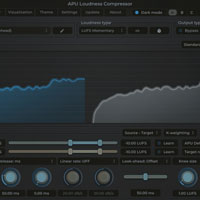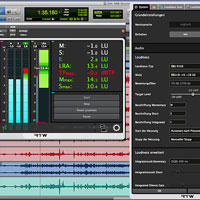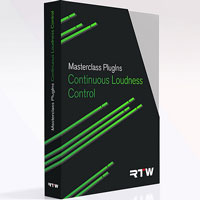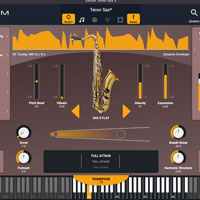APU Software APU Loudness Series v4.4
|  |
APU Loudness Compressor
Real-time LUFS-based compression and more
APU Loudness Compressor is a real-time compressor supporting a variety of loudness types and a rich set of advanced features. You can compress or expand directly within LUFS units, giving the compressor a response which is more perceptually natural and musically relevant.
The primary feature which motivated starting APU Software and building the Loudness Compressor was to integrate LUFS directly into a compressor’s detection circuitry. The Loudness Compressor is my realization of that original goal, and it has evolved to include many more features since then.
If you’d like a more in-depth third-party review of the compressor, check out the videos below:
Loudness Types
One of the key features of this compressor is its support for a variety of loudness types. The compressor’s detection circuitry can be configured to use either LUFS or traditional measurement units (RMS, Peak). You can also choose to split or link channels, which is particularly useful for multi-channel audio formats such as Dolby Atmos®.
The compressor’s detection circuitry can be configured to use any of the following loudness types:
Momentary
Momentary is a short duration LUFS measurement (400ms), which is useful for processing the audio’s moment-by-moment dynamics. This mode is responsive but also transparent, making it an appropriate default for the compressor. K-weighting and channel weighting are applied to the compressor’s detection circuitry, improving perceptual accuracy.
Short-Term
Short-Term is a longer duration LUFS measurement (3 seconds), which is useful for processing the audio’s large scale dynamics. Given the longer duration, this mode is less responsive than momentary, but it can be useful for adjusting the bigger picture of the audio’s dynamics. K-weighting and channel weighting are applied as with momentary.
Integrated
Integrated is an infinite duration LUFS measurement. K-weighting and channel weighting are applied as with momentary, as well as both relative and absolute gating. This loudness type can be useful for continuously wrangling the audio’s integrated loudness toward a specific target range.
RMS
RMS loudness types use a rolling time interval of 150ms by default, which can be adjusted. RMS is a traditional loudness measurement, which is a good first-order approximation of perceived loudness. This mode doesn’t apply K-weighting or channel weighting to the compressor’s detection circuitry, giving it a more traditional character.
True Peak
True Peak loudness types are similar to traditional peak measurements, but they are more accurate as they take into consideration inter-sample peaks. These measurements use a time interval equal to the configured block size (1ms by default). This mode is extremely responsive, making it suitable for very fast attack and release times.
Peak
Peak loudness types are a standard peak circuit, operating on a time interval equal to the configured block size (1ms by default). This is another traditional compressor style measurement. Technically, this mode is even slightly more responsive than True Peak, but it is less accurate as it doesn’t take into consideration inter-sample peaks.
Back to top
Alternate Weighting
In addition to the standard K-weighting for LUFS measurements, the dynamics engine now supports several alternate weighting curves. These curves modify the detector’s frequency response, allowing the dynamics processing to be tailored for specific perceptual goals or technical standards. This can be useful for achieving more transparent results, targeting specific frequency ranges, or emulating the behavior of classic hardware.
The screenshots below are courtesy of the Loudness Contour plugin, which allows visualization of the frequency response of each contour type. For the compressor, the supported weighting types are implemented as zero-latency IIR filters, which allows them to be used in real-time without introducing latency.
ECMA-418
ECMA-418 is a modern standard for perceptual frequency weighting, designed to reflect human hearing sensitivity in typical listening environments. Unlike legacy curves such as A- or C-weighting, ECMA-418 is based on contemporary psychoacoustic research. Using it in the detector can lead to dynamics processing that aligns very closely with perceived loudness, resulting in transparent and natural-sounding compression.
ITU-R 468
ITU-R 468 is a weighting standard designed for measuring noise in broadcast systems. It strongly emphasizes the 1-9 kHz range, making the detector highly sensitive to frequencies associated with harshness or sibilance. This can be creatively used as a frequency-selective compressor to tame harshness in cymbals, vocals, or distorted guitars without needing a separate EQ in the sidechain.
A-weighting
A-weighting approximates human hearing at moderate levels (~40 phon). It has a significant low-frequency roll-off and a broad peak in the mid-range (1-5 kHz). When used in the detector, it causes the compressor to be less reactive to low-frequency content and more sensitive to the mid-range, which can be useful for managing vocal presence or preventing bass frequencies from dominating the compression.
C-weighting
C-weighting has a much flatter response than A-weighting, with less aggressive low-frequency roll-off, and is intended for higher sound pressure levels (~100 phon). Using C-weighting results in dynamics processing that is more responsive to low-frequency energy, making it suitable for full-range material where you want the bass to contribute more significantly to the overall dynamics control.
Back to top
Limiter
The compressor includes a built-in limiter which works seamlessly with the compressor’s attack/release ballistics. The limiter’s look-ahead setting is used to throttle the attack/release ballistics to prevent overshoots and can be configured to operate in Peak or True Peak mode.
Back to top
Dynamic Types
In additional to the unique “Source › Target” mode, the compressor also supports a variety of dynamic types. The compressor can be configured to operate as a traditional downward compressor, upward compressor, downward expander, upward expander, or soft limiting. These modes can be selected using the drop-down menu above the “Dry/Wet” dial.
You may buy APU Software APU Loudness Series v4.4 or download it from our website.
This product was released on 03 Nov 2025. Please check compatibility with your hardware and O/S.
Reviews
Write a Review
From: Your Review: Rating: |









